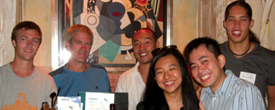By Peter Slavin
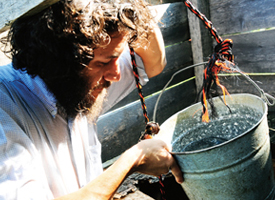
The situation in the Coal River valley was grim. The latest court ruling had been unfavorable. Clear cutting the forest, a forerunner of blasting, had started on the last intact mountain. There was an epic meeting, lasting hours—one that would take the decade-long fight against mountaintop removal (MTR) strip mining in West Virginia in a daring direction.
Mathew Louis-Rosenberg ’05 remembers the 20 or so people crammed together in the little room, the intensity, the talk that “it was time to create an iconic place, an iconic fight,” the doubts that they could organize such an ambitious campaign, the fear that participants would face real danger. Massey Energy, the giant coal company in the valley, played for keeps. Louis-Rosenberg recalls how, in the end, legendary environmental hell-raiser Mike Roselle spoke up and persuaded the rest of them they could do it.
They would undertake a campaign of direct action and nonviolent civil disobedience on mountaintop removal mine sites in the area. Massey would be their primary target and saving Coal River Mountain their immediate aim.
By Ian Barbour ’64

Human beings are related to nature not as isolated individuals but as members of social institutions that have far-reaching impacts on the environment. The environmental crisis raises questions about sustainability, patterns of consumption, and population growth.
Degraded land, eroded soil, and decimated fisheries and forests will take many decades to recover. We are living off biological capital, not biological income. Many of the impacts of our technologies will be felt by future generations. Radioactive wastes from today’s nuclear power plants will endanger anyone exposed to them 10,000 years from now. The world of politics, however, takes a very short-term view. Political leaders find it difficult to look beyond the next election. The main concern of business and industry is this year’s bottom line. Economic calculations give little weight to long-term consequences because a time discount is applied to future costs and benefits.
By David Pacchioli
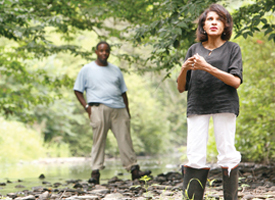
Hop Bottom, Susquehanna County, population 330, is the kind of leafy Pennsylvania hamlet where old men sit on benches in front of the country store, watching the world go by. There’s no cell-phone service, let alone a Starbucks. “Up until two years ago, if you saw three cars together it had to be a funeral,” says one local, nodding toward Main Street.
That world has changed. On a weekday summer morning, the still air echoes with the rumble of heavy trucks: dump trucks and tankers and flatbeds hauling massive equipment. Just up the ridge, cows and horses—and their human neighbors—are getting used to the constant thrum of the drilling rigs and the bright lights that illuminate the well pads through the night. Gangs of hard-hatted workers are clearing land and digging trenches, laying miles of 12-inch pipeline across forest and pasture.
Related Articles

A desperately ill child. A bewildering succession of symptoms, along with a shifting assortment of diagnoses. A seemingly endless series of trial-and-error treatments, which compound a degree of symptom relief with unwelcome and even dangerous side effects. This is the world of severe mental illness, a world that Susan Inman aptly terms “a ridiculous hell.” It is the world that Inman brings to life in her wrenching and courageous memoir of her family’s struggle to care for Molly, their teenager, who has developed a severe psychotic disorder.
By Kenneth Turan ’67
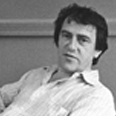
More than 23 years ago, I signed a contract with famed theater producer Joseph Papp to work on a definitive oral history of the New York Shakespeare Festival/Public Theater, the most significant not-for-profit theater group in the country. During the next 18 months, I interviewed close to 160 people and turned nearly 10,000 pages of transcript into a roughly 1,100-page manuscript. I considered it then—and still consider it today—to be the most significant and compelling work I’ve done in more than 40 years of journalism.
By Carol Brévart-Demm

Head soccer coach Eric Wagner, relaxed and smiling, appears right at home in his cozy Field House office, surrounded by family photos and lots of soccer memorabilia, including a Manchester City banner and a giant poster of former Bayern München star Franz Beckenbauer.
 The situation in the Coal River valley was grim. The latest court ruling had been unfavorable. Clear cutting the forest, a forerunner of blasting, had started on the last intact mountain. There was an epic meeting, lasting hours—one that would take the decade-long fight against mountaintop removal (MTR) strip mining in West Virginia in a daring direction.
Mathew Louis-Rosenberg ’05 remembers the 20 or so people crammed together in the little room, the intensity, the talk that “it was time to create an iconic place, an iconic fight,” the doubts that they could organize such an ambitious campaign, the fear that participants would face real danger. Massey Energy, the giant coal company in the valley, played for keeps. Louis-Rosenberg recalls how, in the end, legendary environmental hell-raiser Mike Roselle spoke up and persuaded the rest of them they could do it.
They would undertake a campaign of direct action and nonviolent civil disobedience on mountaintop removal mine sites in the area. Massey would be their primary target and saving Coal River Mountain their immediate aim.
The situation in the Coal River valley was grim. The latest court ruling had been unfavorable. Clear cutting the forest, a forerunner of blasting, had started on the last intact mountain. There was an epic meeting, lasting hours—one that would take the decade-long fight against mountaintop removal (MTR) strip mining in West Virginia in a daring direction.
Mathew Louis-Rosenberg ’05 remembers the 20 or so people crammed together in the little room, the intensity, the talk that “it was time to create an iconic place, an iconic fight,” the doubts that they could organize such an ambitious campaign, the fear that participants would face real danger. Massey Energy, the giant coal company in the valley, played for keeps. Louis-Rosenberg recalls how, in the end, legendary environmental hell-raiser Mike Roselle spoke up and persuaded the rest of them they could do it.
They would undertake a campaign of direct action and nonviolent civil disobedience on mountaintop removal mine sites in the area. Massey would be their primary target and saving Coal River Mountain their immediate aim.  Human beings are related to nature not as isolated individuals but as members of social institutions that have far-reaching impacts on the environment. The environmental crisis raises questions about sustainability, patterns of consumption, and population growth.
Degraded land, eroded soil, and decimated fisheries and forests will take many decades to recover. We are living off biological capital, not biological income. Many of the impacts of our technologies will be felt by future generations. Radioactive wastes from today’s nuclear power plants will endanger anyone exposed to them 10,000 years from now. The world of politics, however, takes a very short-term view. Political leaders find it difficult to look beyond the next election. The main concern of business and industry is this year’s bottom line. Economic calculations give little weight to long-term consequences because a time discount is applied to future costs and benefits.
Human beings are related to nature not as isolated individuals but as members of social institutions that have far-reaching impacts on the environment. The environmental crisis raises questions about sustainability, patterns of consumption, and population growth.
Degraded land, eroded soil, and decimated fisheries and forests will take many decades to recover. We are living off biological capital, not biological income. Many of the impacts of our technologies will be felt by future generations. Radioactive wastes from today’s nuclear power plants will endanger anyone exposed to them 10,000 years from now. The world of politics, however, takes a very short-term view. Political leaders find it difficult to look beyond the next election. The main concern of business and industry is this year’s bottom line. Economic calculations give little weight to long-term consequences because a time discount is applied to future costs and benefits.  Hop Bottom, Susquehanna County, population 330, is the kind of leafy Pennsylvania hamlet where old men sit on benches in front of the country store, watching the world go by. There’s no cell-phone service, let alone a Starbucks. “Up until two years ago, if you saw three cars together it had to be a funeral,” says one local, nodding toward Main Street.
That world has changed. On a weekday summer morning, the still air echoes with the rumble of heavy trucks: dump trucks and tankers and flatbeds hauling massive equipment. Just up the ridge, cows and horses—and their human neighbors—are getting used to the constant thrum of the drilling rigs and the bright lights that illuminate the well pads through the night. Gangs of hard-hatted workers are clearing land and digging trenches, laying miles of 12-inch pipeline across forest and pasture.
Hop Bottom, Susquehanna County, population 330, is the kind of leafy Pennsylvania hamlet where old men sit on benches in front of the country store, watching the world go by. There’s no cell-phone service, let alone a Starbucks. “Up until two years ago, if you saw three cars together it had to be a funeral,” says one local, nodding toward Main Street.
That world has changed. On a weekday summer morning, the still air echoes with the rumble of heavy trucks: dump trucks and tankers and flatbeds hauling massive equipment. Just up the ridge, cows and horses—and their human neighbors—are getting used to the constant thrum of the drilling rigs and the bright lights that illuminate the well pads through the night. Gangs of hard-hatted workers are clearing land and digging trenches, laying miles of 12-inch pipeline across forest and pasture. 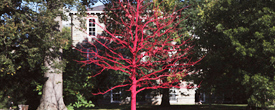
 A desperately ill child. A bewildering succession of symptoms, along with a shifting assortment of diagnoses. A seemingly endless series of trial-and-error treatments, which compound a degree of symptom relief with unwelcome and even dangerous side effects. This is the world of severe mental illness, a world that Susan Inman aptly terms “a ridiculous hell.” It is the world that Inman brings to life in her wrenching and courageous memoir of her family’s struggle to care for Molly, their teenager, who has developed a severe psychotic disorder.
A desperately ill child. A bewildering succession of symptoms, along with a shifting assortment of diagnoses. A seemingly endless series of trial-and-error treatments, which compound a degree of symptom relief with unwelcome and even dangerous side effects. This is the world of severe mental illness, a world that Susan Inman aptly terms “a ridiculous hell.” It is the world that Inman brings to life in her wrenching and courageous memoir of her family’s struggle to care for Molly, their teenager, who has developed a severe psychotic disorder.
 More than 23 years ago, I signed a contract with famed theater producer Joseph Papp to work on a definitive oral history of the New York Shakespeare Festival/Public Theater, the most significant not-for-profit theater group in the country. During the next 18 months, I interviewed close to 160 people and turned nearly 10,000 pages of transcript into a roughly 1,100-page manuscript. I considered it then—and still consider it today—to be the most significant and compelling work I’ve done in more than 40 years of journalism.
More than 23 years ago, I signed a contract with famed theater producer Joseph Papp to work on a definitive oral history of the New York Shakespeare Festival/Public Theater, the most significant not-for-profit theater group in the country. During the next 18 months, I interviewed close to 160 people and turned nearly 10,000 pages of transcript into a roughly 1,100-page manuscript. I considered it then—and still consider it today—to be the most significant and compelling work I’ve done in more than 40 years of journalism.
 Head soccer coach Eric Wagner, relaxed and smiling, appears right at home in his cozy Field House office, surrounded by family photos and lots of soccer memorabilia, including a Manchester City banner and a giant poster of former Bayern München star Franz Beckenbauer.
Head soccer coach Eric Wagner, relaxed and smiling, appears right at home in his cozy Field House office, surrounded by family photos and lots of soccer memorabilia, including a Manchester City banner and a giant poster of former Bayern München star Franz Beckenbauer.
